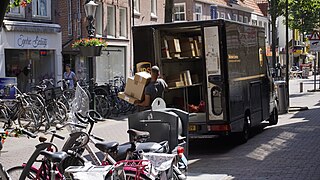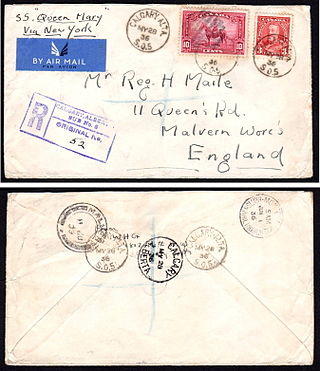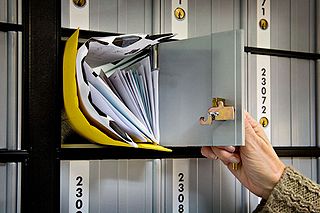
The United States Postal Service (USPS), also known as the Post Office, U.S. Mail, or simply the Postal Service, is an independent agency of the executive branch of the United States federal government responsible for providing postal service in the United States, its insular areas and associated states. It is one of a few government agencies explicitly authorized by the Constitution of the United States. As of 2023, the USPS has 525,469 career employees and 114,623 non-career employees.
Canada Post Corporation, trading as Canada Post, is a Canadian Crown corporation that functions as the primary postal operator in Canada.

Package delivery or parcel delivery is the delivery of shipping containers, parcels, or high-value mail as single shipments. The service is provided by most postal systems, express mail, private courier companies, and less-than-truckload shipping carriers. Package delivery is different in each country, and how packages are delivered is closely connected with the cost for delivering to that country as well as population. In 2019, China, The United States, and Japan were the leaders in package delivery while Latvia, Macau, and Iceland were the bottom three. The population of the bottom three barely totals 2 million while the population of the top three tops totals more than 2 billion. Package delivery is an every day occurrence in the US while many other countries do not have this luxury.
The Private Express Statutes (PES) are a group of United States federal civil and criminal laws placing various restrictions on the carriage and delivery of letters by all organizations other than the United States Postal Service.

Registered mail is a postal service in many countries which allows the sender proof of mailing via a receipt and, upon request, electronic verification that an article was delivered or that a delivery attempt was made. Depending on the country, additional services may also be available, such as:

Australia Post, formally the Australian Postal Corporation and also known as AusPost, is an Australian Government-owned corporation that provides postal services throughout Australia. Australia Post's head office is located on Swan Street in Richmond Victoria.

A post office box is a uniquely addressable lockable box located on the premises of a post office.

A letter box, letterbox, letter plate, letter hole, mail slot or mailbox is a receptacle for receiving incoming mail at a private residence or business. For outgoing mail, post boxes are often used for depositing the mail for collection, although some letter boxes are also capable of holding outgoing mail for a carrier to pick up. Letterboxes or mailboxes use the following primary designs:
Within the United States, a commercial mail receiving agency (CMRA) is a private business that accepts mail from the Postal Service on behalf of third parties. A CMRA may also be colloquially known as a mail drop. A mailbox at a CMRA is called a private mailbox (PMB).

Rural Free Delivery (RFD), since 1906 officially rural delivery, is a program of the United States Post Office Department to deliver mail directly to rural destinations. The program began in the late 19th century. Before that, people living in rural areas had to pick up mail themselves at sometimes distant post offices or pay private carriers for delivery.
Post offices and other mail service providers typically offer a mail forwarding service, commonly known as hybrid mail or virtual post office box services, to redirect mail addressed to one location to another address – usually for a given period. In the case of the United States Postal Service's First Class Mail, it is generally for a period of one year. British Royal Mail provides a service called Mail Redirection, enabling redirection for up to two years. Customers of such a service usually, but not exclusively, use mail forwarding when they change an address.

Parcel post is a postal service for mail that is too heavy for normal letter post. It is usually slower than letter post. The development of the parcel post is closely connected with the development of the railway network which enabled parcels to be carried in bulk, to a regular schedule, and at economical prices. Today, many parcels also travel by road and international shipments may travel by sea or airmail.

Rural letter carriers are United States Postal Service and Canada Post employees who deliver mail in what are traditionally considered rural and suburban areas of the United States and Canada. Before Rural Free Delivery (RFD), rural Americans and Canadians were required to go to a post office to get their mail.

The Jeep DJ is a two-wheel drive variant of the four-wheel drive CJ series. Production started in 1955 by Willys, which was renamed Kaiser Jeep in 1963. In 1970, American Motors Corporation (AMC) purchased Kaiser's money-losing Jeep operations and established AM General, a wholly owned subsidiary that built the DJ through 1984.

U.S. Special Delivery was a postal service paid for with additional postage for urgent letters and postal packets which are delivered in less time than by standard or first class mail service. Its meaning is different and separate from express mail delivery service. Essentially it meant that a postal packet was delivered from a post office to the addressee immediately once it arrived at the post office responsible for delivering it, rather than waiting for the next regular delivery to the addressee.

The Intelligent Mail Barcode (IMb) is a 65-bar barcode for use on mail in the United States. The term "Intelligent Mail" refers to services offered by the United States Postal Service for domestic mail delivery. The IM barcode is intended to provide greater information and functionality than its predecessors POSTNET and PLANET. An Intelligent Mail barcode has also been referred to as a One Code Solution and a 4-State Customer Barcode, abbreviated 4CB, 4-CB or USPS4CB. The complete specification can be found in USPS Document USPS-B-3200. It effectively incorporates the routing ZIP Code and tracking information included in previously used postal barcode standards.
Centralized mail delivery is a unique form of mail delivery system where a letter carrier provides delivery and collection services to a number of residences from a centrally located installation – whether in a single-family subdivision or multi-family structure. Business customers also receive delivery services from a convenient central location. Centralized mail delivery equipment can be in the form of any "clustered" type mailbox – including free-standing, pedestal-mounted cluster box unit (CBU), or other cluster mailboxes mounted in a wall, kiosk, or shelter. The U.S. Postal Service prefers centralized mail delivery in all new construction because it is less expensive. The United States Postal Service aims to continue to review and modify its operations to provide universal service as efficiently and cost effectively as possible. Therefore, there is pressure to establish centralized mail delivery, which is required in some communities.

Package tracking or package logging is the process of localizing shipping containers, mail and parcel post at different points of time during sorting, warehousing, and package delivery to verify their provenance and to predict and aid delivery.

An arrow lock is a lock with standard dimensions used by the United States Postal Service for mail carriers to access collection boxes, outdoor parcel lockers, cluster box units, and apartment mailbox panels. Arrow locks are unlocked through the use of a corresponding arrow key. Arrow locks are also referred to as "Master Access Locks"

A parcel locker is an automated postal box that allows users for a self-service collection of parcels and oversize letters as well as the dispatch of parcels.














